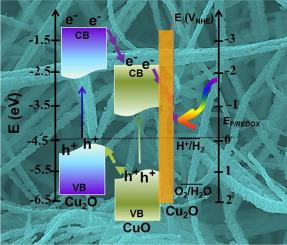Applied Surface Science ( IF 6.7 ) Pub Date : 2021-02-23 , DOI: 10.1016/j.apsusc.2021.149375 Young Jun Seo , Maheswari Arunachalam , Kwang-Soon Ahn , Soon Hyung Kang

|
Mono and divalent copper oxide (Cu2O and CuO) has been considered as a potential semiconductor photocathode with capability for hydrogen (H2) production. The use of one-dimensional (1D) nanostructures as photocathode is desirable for the photoelectrochemical water-splitting device due to the large surface areas, lateral carrier extraction property, and excellent light-harvesting potentiality. Accordingly, the numerous attempts to develop copper oxide heterojunctions via a bottom-up approach has been achieved, but, the resulting composites have suffered from the poor interfacial configuration. Here, we demonstrate the intimate modulation through the different ambient annealing of photocathodes could alter the nanostructure, light-harvesting, and optical bandgap. Accordingly, the Cu2O/CuO heterostructure was synthesized by in situ growth via simple electrochemical anodization of Cu foil followed by annealing in air, and then the surfaces of the heterostructure were sequentially modified by the formation of Cu(OH)2 via the post-annealing process under 4% hydrogen-argon mixed gas at 300 °C. As a result, a mild hydrogen treatment (H2@1min) was found to be effective in enhancing the PEC properties, due to the favorable formation of Cu2O/CuO/Cu(OH)2 layer, promoting the photogenerated charge collection yield; the generation of sufficient cation vacancies was closely related to the electronic conductivity and the charge-transfer yield. The TEM and XPS results confirmed that the hydrogen treatment found a slightly thin Cu(OH)2 layer was produced as an efficient co-catalyst from the inherent chemical reduction of prominent CuO phase to develop the junction of Cu2O/CuO/Cu(OH)2. Overall, the Cu2O/CuO/Cu(OH)2(H2@1min) film exhibited an obvious improvement in photocurrent density of −2.3 mA/cm2 at 0 V vs. reversible hydrogen electrode (RHE) (abbreviated as 0 VRHE) than those nanowires having −1.72 and −1.44 mA/cm2 of both Cu2O/CuO/Cu(H2@3min) and Cu2O/CuO(Air), respectively.
中文翻译:

通过氢处理集成杂化的Cu 2 O / CuO光电阴极界面,以进行光电化学制氢反应
一价和二价的氧化铜(Cu 2 O和CuO)被认为是具有生产氢(H 2)能力的潜在半导体光电阴极。一维(1D)纳米结构用作光阴极对于光电化学水分解装置是理想的,这是由于其大的表面积,横向的载流子提取特性和极好的光收集潜力。因此,已经实现了通过自下而上的方法开发铜氧化物异质结的许多尝试,但是,所得的复合材料遭受了不良的界面构型的困扰。在这里,我们证明了通过光阴极的不同环境退火进行的紧密调制可以改变纳米结构,光收集和光学带隙。因此,铜2 O / CuO异质结构是通过Cu箔的简单电化学阳极氧化原位生长,然后在空气中退火而合成的,然后通过后退火工艺形成Cu(OH)2依次修饰异质结构的表面。300°C下4%的氢氩混合气体。结果,由于有利地形成了Cu 2 O / CuO / Cu(OH)2,温和的氢处理(H 2 @ 1min)被发现可以有效地增强PEC性能。层,提高光生电荷收集率;足够的阳离子空位的产生与电子电导率和电荷转移产率密切相关。的TEM和XPS的结果证实,氢处理时,发现稍微薄的Cu(OH)2层,制作从固有的化学还原突出的CuO相的有效助催化剂,开发Cu的结2 O / CuO的/铜( OH)2。总体而言,与可逆氢电极(RHE)相比,Cu 2 O / CuO / Cu(OH)2(H 2 @ 1min)膜在0 V时的光电流密度为-2.3 mA / cm 2,具有明显的改善(缩写为0)。 V RHE)分别比具有分别为Cu 2 O / CuO / Cu(H 2 @ 3min)和-Cu 2 O / CuO(空气)的-1.72和-1.44 mA / cm 2的那些纳米线。


























 京公网安备 11010802027423号
京公网安备 11010802027423号